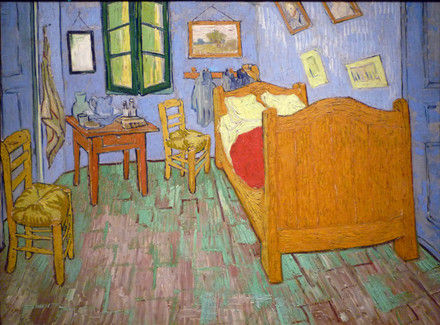双语揭秘:梵高8个未解之谜(组图)

扫描关注少儿英语微信
 梵高8个未解之谜
梵高8个未解之谜Today is the birthday of one of the art world's most beloved outsiders, the iconic post-Impressionist whose melancholic spirit and rapturous paintings forever colored our notion of the "tortured artist." Yes, we're talking about Vincent van Gogh, a man whose life is as widely renowned as it is shrouded in mystery。今天是艺术世界中一位令人深受爱戴的艺术家的生日,这位图形派后印象主义画家,他的抑郁精神和狂放风格的绘画作品在我们心中永久地留下了一个对“扭曲派艺术家”的概念。是的,我们谈论梵高,他的人生声名远扬,同样也如此神秘。
Was van Gogh really as unstable as he seemed? Are his paintings actually changing over time? And what's with the ear already? Today, on what would have been his 162nd birthday, we're exploring some of the theories and discoveries that continue to make van Gogh not only one of the most talented but one of the most beguiling artists of all time。梵高真的就像他看起来那么的善变吗?他的画作真的会随着时间而改变吗?他的耳朵到底是怎么了?今天,在他的第162个生日之际,我们来探索一下那些使梵高不仅成为最具天赋的画家,同时也一直是一个独具魅力的画家的理论和发现。
 梵高8个未解之谜
梵高8个未解之谜He may have hidden "The Last Supper" in one of his paintings。他可能把“最后的晚餐”藏在了他其中一幅画作中。
On the surface, van Gogh's "Cafe Terrace at Night" seems to depict a group of nondescript patrons socializing at a cafe. 从表面上看,梵高的作品“夜间露天咖啡座”似乎在描述一群平凡无奇的老顾客在咖啡店里的社交活动。
However, according to researchers like Jared Baxter, the moonlit scene may actually be a work of religious symbolism, a subtle nod to Leonardo da Vinci's "The Last Supper."然而,根据像Jared Baxter这样调查者的描述,其中的月光场景可能就是一种宗教象征,一种和达芬奇“最后的晚餐”的微妙契合。
 梵高8个未解之谜
梵高8个未解之谜His work may have accurately rendered one of the most complex scientific principles in history。他的作品可能准确地描绘出历史中其中一个最复杂的科学理论。
"When I meet God, I am going to ask him two questions: Why relativity? And why turbulence? I really believe he will have an answer for the first," the 20th century German theoretical physicist Werner Heisenberg famously said.20世纪德国物理理论学家维尔纳·海森堡曾说:“当我遇见上帝的时候,我将问他两个问题:为什么有相对性?为什么又有动荡性?我坚信他会给我第一个问题的答案。”
Turbulence, for the not-so-scientifically literate, is a wildly complex theory that still has many scientists baffled. It also happens to be a theory best visualized by swirling patterns reminiscent of van Gogh's painted atmospheres, specifically those in works like "Starry Night."动荡性,作为一种不太合乎科学的文学,是一种令很多科学家感到困惑的复杂理论。但它也恰好是最能够通过梵高作品中那些旋涡式的图形而直观起来的理论,尤其是像“星空”这样的作品。
Some theorize that at times of turmoil in his life, such as his stay in a mental asylum, van Gogh somehow tapped into the artistic side of the scientific theory. Watch the video above for more details。其中一些理论是在梵高那些混乱的人生阶段中建立起来的,比如他在精神病院的那段时间,梵高在某种程度上将在艺术的边界上挖掘出了科学的理论。
 梵高8个未解之谜
梵高8个未解之谜His sunflowers were probably mutants。他的向日葵也许是变异体。
Did you ever notice that van Gogh's iconic sunflowers don't look like the ones you've passed by on road trips? That's because, according to researchers like John Burke of the University of Georgia, van Gogh was not painting your standard sunflower, but rather variants holding a single mutant gene, thus resembling "wooly, chrysanthemum-like" flowers, reminiscent of "fuzzy pom-poms stuck on sunflower stems."你是否注意过梵高的向日葵和你在路边看到的不太一样?根据乔治亚大学研究者John Burke的发现,梵高并没有在画你们所认识的向日葵,而是在画一个变异种的向日葵,所以看起来像一些毛茸茸的菊花样的花,让人联想到一战时那机关炮打在了向日葵的茎上。
 梵高8个未解之谜
梵高8个未解之谜He may have been colorblind。他也许是个色盲。
Did van Gogh have trouble perceiving reddish tones? According to Kazunori Asad, a Japanese vision expert, the answer to this question might explain Vincent's cool-heavy color palette and rough style. 梵高对微红色系的感知有障碍吗?一位日本视觉专家Kazunori Asad说,这个问题的答案也许可以解释梵高画作中惯用的冷色系和狂放的风格。
Asad developed an app titled "Chromatic Vision Simulator," which simulates the experience of particular kinds of color blindness, including van Gogh's possible protanopia. "Asad 开发了一款名为“色觉模拟器”的应用,它可以模拟梵高可能患有的红色盲症在内的特定色盲症患者的体验,也包括梵高可能患有的红色盲症。
 梵高8个未解之谜
梵高8个未解之谜He may not have chopped off his own ear。他可能没有割掉自己的耳朵。
We know, we know. How do we even begin to comprehend a world in which van Gogh that didn't cut off his own ear and deliver it to a lady named Rachel?我们知道,我们知道。假设梵高没有割掉自己的耳朵并给了一个叫瑞秋的女人,我们又是如何开始去理解在这个世界里的梵高的。
Well, Hamburg-based historians Hans Kaufmann and Rita Wildegans insist that Vincent van Gogh may have made the whole thing up to protect the real culprit, his friend Paul Gauguin, who could have chopped it off during an argument. 然而,汉堡历史学家Hans Kaufmann和Rita Wildegans坚持认为梵高可能掩盖了事实去为真正的罪犯辩护,就是他的朋友保罗·高更,也许是在他们的一次争执中割掉了梵高的耳朵。
Evidence backing this claim includes a letter van Gogh wrote to Gauguin, which reads: "I will keep quiet about this and so will you."支撑这一说法的证据来源于一封梵高写给高更的信,信上说:“我将会保守秘密,你也是。”
 梵高8个未解之谜
梵高8个未解之谜He may not be as manic as the legends assert。他也许并没有如传言中那么躁狂。
Although his reputation paints him as an impetuous creative, many historians believe van Gogh was more traditional and analytic than he's often thought to be. 尽管他的声誉是以一个鲁莽的创意人士而打造,但很多历史学家认为梵高比通常人们印象中更传统更理性。
For example, his iconic "Bedroom" is known now for the jarring contrast between the blue walls and yellow floors, yielding a dizzying and somewhat dark effect. 比如说,他的作品“卧室”是以蓝色墙壁和黄色地面的不和谐反差而被人所知,产生一种令人眼花缭乱和一些忧郁的效果。
However, researchers discovered the blue paint was originally more of a violet, which was both a traditional foil to yellow and a calmer hue in general。然而,研究者发现其中的蓝色更接近紫罗兰色,是黄色的传统搭配,色彩度从总体上也显得更平静。
 梵高8个未解之谜
梵高8个未解之谜He might have been murdered。他也许是被谋杀的。
Although the most well-known narrative of Van Gogh's life ends with suicide, soe argue that it was in fact murder that brought about the artist's untimely death at 37 years old. 尽管最广为流传的说法是梵高死于自杀,但特殊行动执行局说事实上是一起谋杀结束了这位年仅37岁的艺术家。
For one, evidence purports that he shot himself in the midsection, and then walked for a mile back to his room afterwards, a rather unlikely scenario. 一方面,迹象表明他射击了自己的上腹部,然后又走了一英里回到自己的房间,这几乎是个不可能的情形。
It could be van Gogh's skyrocketing celebrity and persona as a tortured soul that allowed the ruling of suicide to slip by with very little physical support and no indication that van Gogh wanted his life to end。有可能是梵高名声鹊起和他以拥有扭曲灵魂的人物角色,才让他的自杀消息在还几乎还没有得到生理检查时就不胫而走,并且没有迹象表明梵高想结束他的生命。
他杀!深扒梵高之死的惊人真相!!!
 梵高8个未解之谜
梵高8个未解之谜His paintings are slowly turning white。他的画作逐渐在向白色调发展。
Van Gogh took a particular liking to one of the first synthetically-made paints, manufactured from red lead, or plumbonacrite. Sadly, the material doesn't hold up well, causing bold colors including red to degrade rapidly when exposed to light. 梵高对其中一幅综合色调的画作情有独钟,由红铅和白铅绘制而成。不幸的是,材料的粘附性不是很强,一些包括红色在内的深色一旦暴露在阳光中就迅速褪色。
Francesca Casadio, a scientist with the Art Institute of Chicago, explained: "We have known for some time that some of the pigments
that van Gogh used alter with time. But honestly I was quite surprised to find that the red lead, the mineral pigment that typically is considered relatively stable, also failed him."芝加哥艺术学院的科学家Francesca Casadio解释说:“我们已经对梵高在不同时期使用的一些颜料有了了解。但说实话让我很惊讶的是,像红铅这样的按理说非常稳定的矿物颜料,也同样让他失败。”
(沪江英语)
- 学规划:国外知乎教你如何成为学霸(双语)2015-04-01 10:26
- 跟着时间走:全天候减肥大作战(双语)2015-04-01 10:23
- 双语:为防孩子受色情画面影响MV将分级(图)2015-04-01 10:09
- 经典双语美文欣赏:良师乃人生一幸(图)2015-04-01 09:57
- 双语阅读:如何才能成为世界首富2015-04-01 09:57

